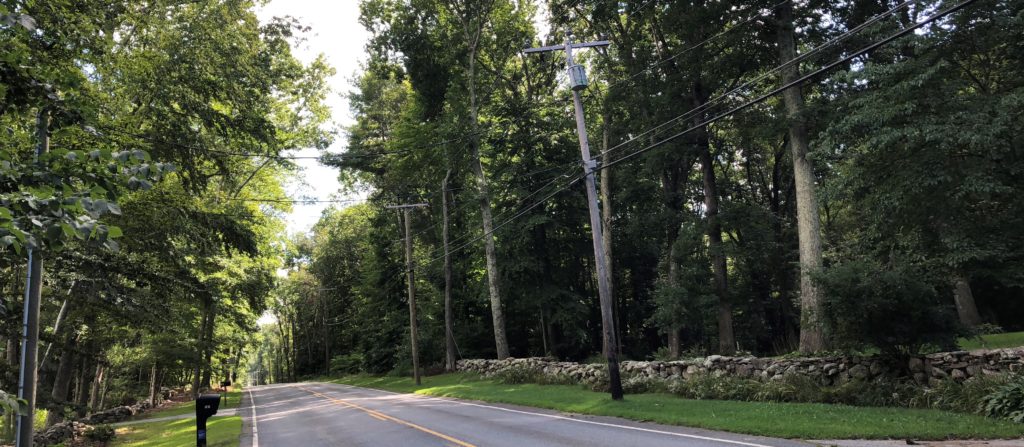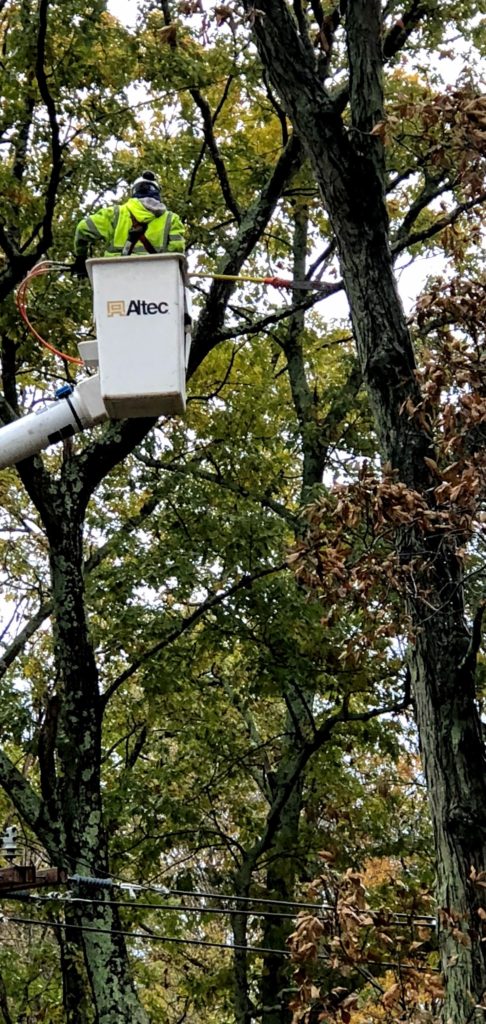A Partnership of UConn and Eversource
Eversource Energy Center
Improving Vegetation Management Effectiveness with Remote Sensing, Outreach, and Forest-Science

Highlights
- Enhance geospatial support tool for prioritizing treatment areas for vegetation management programs (Stormwise and tree trimming).
- Develop methods for mapping and forecasting forest health and tree mortality.
- Improve vegetation risk models by incorporating corrected power line maps and forest health factors.
- Evaluate the effect of Stormwise and tree trimming on tree failure and stability.
- Identification of socioeconomic barriers and mitigation strategies for implementation of vegetation management programs.
- Develop spatial predictions of stakeholder receptivity to vegetation management programs.
Background
Mitigating vegetation-related risks to infrastructure is a major challenge to utilities in forested regions and vegetation management is one of the largest recurring expenses to utilities across North America. Vegetation management programs can be made more efficient and effective with the help of decisions support systems incorporating relevant geospatial and socioeconomic data as well as knowledge of the effectiveness of alternative vegetation management approaches. This program seeks to develop methods and collect data to 1) improve targeting of treatment areas with ongoing remote monitoring of vegetation conditions using ground-, air- and space-borne sensors, 2) understand socioeconomic barriers to treatment implementation and develop outreach strategies to mitigate these barriers, and 3) assess the impact of different vegetation management options on tree failure and stability. The proposed tasks would expand on previous Eversource Energy Center research to provide a more complete and operational decision support for managing vegetation to reduce power outage occurrences.
Needs

The silvicultural literature suggests that the Stormwise vegetation management program, developed through Eversource Energy Center research, will be an effective long-term solution for reducing power outages in rural forested areas. However, there is currently no data available to provide empirical support for the program’s effectiveness. Analyses to date have shown that Enhanced Tree Trimming (ETT) is effective in reducing total numbers of outages but it remains unclear whether ETT has any effect on reducing physical damages which are often associated with tree failures occurring outside the utility protection zone. Furthermore, the tree biomechanics literature suggests that the drastic crown alterations and tree removals, a common result of ETT, can lead to reduced tree stability and potential for increased risk of whole tree failures. Finally, socioeconomic issues can make Stormwise and ETT programs challenging to implement across broad areas. The tasks below aim to address the challenges associated with the implementation of vegetation management programs.
Prioritizing treatment areas for vegetation management programs:
- Enhance web-based geospatial support tool for prioritizing treatment areas for vegetation management programs including Stormwise and Enhanced Trimming.
- Improve vegetation risk models using updated power line maps and incorporating forest health and structure risk factors.
- Develop procedures for assessing forest health and mapping current tree mortality using remote sensing.
- Develop predictive models of future tree mortality.
- Site suitability analysis for Stormwise applications.
Evaluating the impact of vegetation management programs on tree failure and stability:
- Multi-temporal mapping of tree failure events in Stormwise treatment and control areas derived using unmanned aerial system and ground-based monitoring.
- Multi-temporal mapping of tree crown symmetry, stand species composition, and stand structure and density at Stormwise treatment and control areas.
- Continued monitoring of tree sway in the three existing Stormwise tree biomechanics research sites.
- Implementation of new tree biomechanics research sites focused on monitoring sway characteristics for ETT and SMT sites.
Socioeconomic barriers and mitigation strategies for implementing vegetation management programs:
- Identify socioeconomic barriers and opportunities to implementation of vegetation management programs.
- Develop outreach methods to overcome social barriers to implementation.
- Develop geospatial predictions of perceived receptivity of communities to Stormwise and other vegetation management programs to support treatment area prioritization.
Expected Deliverables
This research will create the following products:
- Web-based geospatial decision support tool to help in prioritizing treatment areas for vegetation management including Stormwise and enhanced trimming.
- Geospatial datasets mapping: forest health and mortality, predictions of future forest health and mortality, predicted receptivity to vegetation management programs.
- Report on Stormwise treatment effectiveness.
- Report on the effects of Stormwise, ETT, and SMT on tree stability.
- Report on outreach activities and socioeconomic barriers to Stormwise and tree trimming as well as proposed outreach strategies for mitigation.
Points of Contact
- Eversource: Sean Redding
- UConn: Robert Fahey